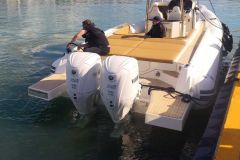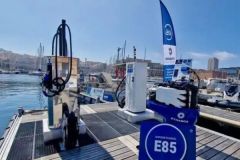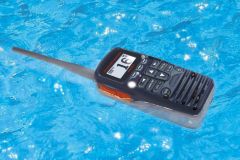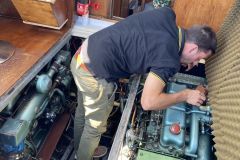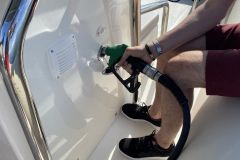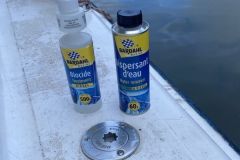On August 26, 2020, in the small Italian port of Ponza, the port surveillance camera recorded the explosion of a boat. It caught fire after its occupants filled the fuel tank. This event, which did not cause any casualties, gives us the opportunity to review the precautions that boaters should take when filling the fuel tanks of our boats.
What do we see on this video? A lady who has just filled up her boat with gas, is getting ready to leave the "fuel pontoon". She is holding the stern line, ready to cast off when the engine starts. At the moment when, presumably, the ignition is turned on, an explosion occurs, which ejects this lady and causes a rather strong panic in the harbor.
Let's analyze this video and try to find the good and bad reflexes to acquire in order to fill up your gas tank without risk.
The schedule at which this filling is carried out
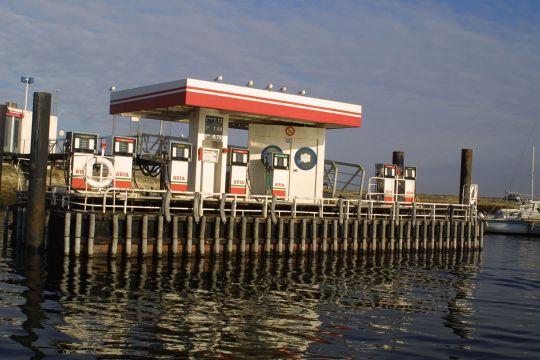
It is about 2pm on this video. This is one of the hottest times of the day when the sun is at its peak and will create the most explosive gasoline vapors. In addition, the gasified fuel will spin the volume meter at the pump (you'll be paying for gaseous fuel that never goes into your tank). So there is no point in doing this on a hot day.
Tip: fill up your tank at the coolest time of the day, i.e. very early in the morning, you will also benefit from a purer fuel, as the deposits at the bottom of the tank will not have been suspended in the fuel by each fill-up during the day.
Dump the boat before starting the engine?
Although she was apparently getting ready to leave the fuel dock, the sailor in this video will have jettisoned her boat before the engine was started, which in all likelihood caused the fatal spark. A bad idea if ever there was one. We end up with a boat on fire, without propulsion - therefore uncontrollable - and without a mooring. If keeping the boat moored until the engines started would not have prevented this event, it would have kept the vessel in close proximity to the dock, thus facilitating the intervention of firefighting equipment.
Ventilate the engine hold when refueling
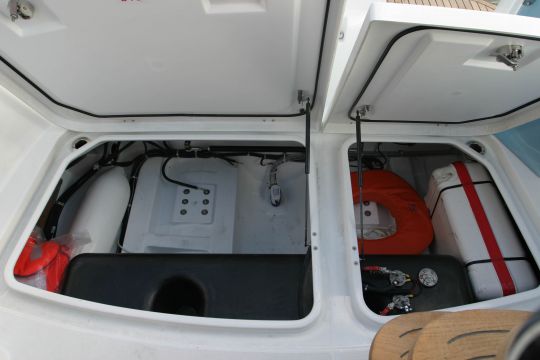
Even if the video does not show it clearly, the fact that the foams of the sunbeds fly away at the time of the detonation suggests that the boat is in "navigation" mode. That is to say, engine compartment closed, hold closed. In other words, the cloud of detonating fuel vapour has plenty of time to form in the hold and explode.
If we consider that gasoline is explosive from a concentration of 1.3% (a concentration of 1.3 liters of super gasoline vapor in 100 liters of air is sufficient) on the one hand, and on the other hand that the exhaust gases can reach temperatures close to 600°C (and gasoline a self-ignition temperature of about 300°C), everything was in place for this explosion to occur.
Tip: before refueling, let the engine cool down (a few tens of minutes). Before, during and after this filling operation, if necessary by placing yourself at the end of the fuel pontoon or on an adjacent pontoon so as not to disturb other users, ventilate the engine and fuel holds. Ideally, install a gas detector, it will alert you when the concentration becomes critical before reaching an explosive potential.
No means of extinction
Don't see any fire extinguishers in this video? We don't either! Don't rely on the fact that the dispensing location is equipped with one. This is your boat and your safety. Take the fire extinguisher out of the boat and put it in position (and take the opportunity to check that it still has its pin and that it has not exceeded its validity date). Know how to use a fire extinguisher and make sure that all adults on board are able to use it and know where it is located, and that they don't hesitate to use it if necessary, even if it wasn't absolutely necessary. It is obviously better to have to replace a struck fire extinguisher for nothing than a boat destroyed by flames!
The outfit of the team members

These pictures show a barefoot lady in a bathing suit and a gentleman in the same outfit. Walking around without shoes on board can be justified at anchor, for comfort. When sailing, possibly also. But never during a technical operation, especially when this operation involves handling hydrocarbons, which are slippery by definition. Therefore, as a matter of principle, when maneuvering or filling up with fuel, shoes should be worn so as not to slip too much if the boat moves while filling up.
Securing the ship
What do we see when the entire crew has left the ship? A lady ejected by the explosion, a harbor worker who falls into the water, and a passenger on the boat who, coming to the news, slips and falls into the water. And a drunken boat that goes off, drifting away, because it is no longerâeuros¦ moored! Would you fill up your car without applying the handbrake?
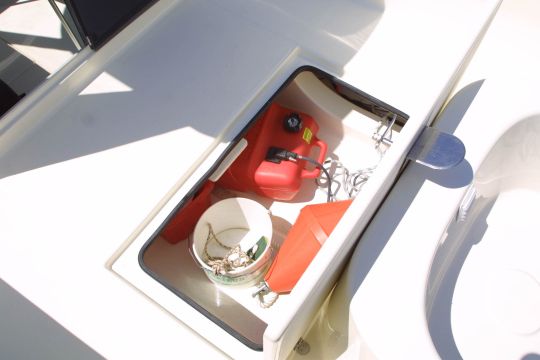
The response to the incident
Gérard Oury said " I like exceptional situations and the way ordinary characters react to them. "The haphazard reactions of all those involved in this scene show an unpreparedness that could have turned out to be dramatic. The absence of the minimum safety equipment on the fuel pontoon (no buoy, no fire extinguisher immediately available, no ladder to go ashoreâ?¦), it is sometimes better to travel a few extra miles to fill up with gas in a place that marine common sense will make feel more "safe".
As a captain
The title of "captain" charges you with a certain number of responsibilities, the first being to ensure the safety of your crew, at all times and in all actions. This responsibility requires you to imagine the worst to avoid it. This video demonstrates that this was not the case and how negligence can have serious consequences. The skipper has legal authority on board the boat and it is your responsibility, during an operation as risky as refueling, that none of the crew members do anything dangerous (from the teenager who decides to plug in his phone to the husband who lights a cigarette or heats up a coffee).
Tip: A good solution to manage your crew is to disembark everyone at the time of filling, to send them to the toilets of the port, to buy an ice creamâeuros¦ In short, to make sure that they are safe in case of incident on the one hand, and on the other hand to prevent them from making this mistake with heavy consequences.

Checklist before filling up with gas
- Cut off the power supplies as close as possible to the batteries
- Turn off all cell phones and portable VHF
- Wear real shoes that don't slip
- Disembark the whole crew
- Put on your life jacket
- Moor the boat
- Open the engine and fuel chambers wide
- Close the gas cylinder
- Take out the fire extinguisher
When you fill up your tank, keep in mind this video and tell yourself that this lady, too, considered filling up her tank to be a harmless act!




